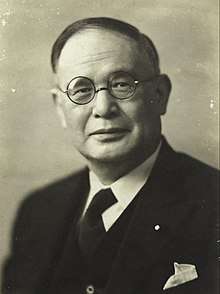1953 Japanese House of Councillors election
House of Councillors elections were held in Japan on 24 April 1953,[1] electing half the seats in the House. The Yoshida faction of the Liberal Party won the most seats.
| |||||||||||||||||||||||||||||||||||||||||||||||||||||||||||||
125 (of the 250) seats in the House of Councillors 126 seats needed for a majority | |||||||||||||||||||||||||||||||||||||||||||||||||||||||||||||
|---|---|---|---|---|---|---|---|---|---|---|---|---|---|---|---|---|---|---|---|---|---|---|---|---|---|---|---|---|---|---|---|---|---|---|---|---|---|---|---|---|---|---|---|---|---|---|---|---|---|---|---|---|---|---|---|---|---|---|---|---|---|
| |||||||||||||||||||||||||||||||||||||||||||||||||||||||||||||
| |||||||||||||||||||||||||||||||||||||||||||||||||||||||||||||
 |
|---|
| This article is part of a series on the politics and government of Japan |
|
|
|
|
Results
| Party | Constituency | National | Total seats | |||||
|---|---|---|---|---|---|---|---|---|
| Votes | % | Seats | Votes | % | Seats | |||
| Liberal Party | 8,803,131 | 31.4 | 30 | 6,149,927 | 22.7 | 16 | 46 | |
| Leftist Socialist Party of Japan | 3,917,837 | 14.0 | 10 | 3,858,552 | 14.3 | 8 | 18 | |
| Rightist Socialist Party of Japan | 2,952,803 | 10.5 | 7 | 1,740,423 | 6.4 | 3 | 10 | |
| Kaishintō | 2,840,345 | 10.1 | 5 | 1,630,507 | 6.0 | 3 | 8 | |
| Ryokufūkai | 2,096,103 | 7.5 | 8 | 3,301,011 | 12.2 | 8 | 16 | |
| Liberal Party–Hatoyama | 522,540 | 1.9 | 0 | 110,889 | 0.4 | 0 | 0 | |
| Labourers and Farmers Party | 277,422 | 1.0 | 0 | 112,535 | 0.4 | 0 | 0 | |
| Japanese Communist Party | 264,729 | 0.9 | 0 | 293,877 | 1.1 | 0 | 0 | |
| Other parties | 322,674 | 1.2 | 1 | 332,898 | 1.2 | 0 | 1 | |
| Independents | 6,013,363 | 21.5 | 14 | 9,504,220 | 35.2 | 15 | 29 | |
| Invalid/blank votes | - | - | - | - | - | |||
| Total | 28,010,967 | 100 | 75 | 27,034,839 | 100 | 53 | 128 | |
| Source: Ministry of Internal Affairs and Communications | ||||||||
gollark: ?coliru```haskellimport Control.Applicativeimport Data.Listimport Data.Monoidimport Control.Monada :: String -> Stringa x = (intercalate (a x) $ tails x)main = putStr$take 100$a"Python is fine"```
gollark: ?coliru```haskellimport Control.Applicativeimport Data.Listimport Data.Monoidimport Control.Monada :: String -> Stringa x = (intercalate (a x) $ inits x)main = putStr$take 100$a"Python is fine"```
gollark: ?coliru```haskellimport Control.Applicativeimport Data.Listimport Data.Monoidimport Control.Monada :: String -> Stringa x = (intercalate (a x) $ (inits x <> tails x))main = putStr$take 100$a"BCD"```
gollark: ?coliru```haskellimport Control.Applicativeimport Data.Listimport Data.Monoidimport Control.Monada :: String -> Stringa x = (intercalate (a x) $ tails x)main = putStr$take 100$a"BCD"```
gollark: ?coliru```haskellimport Control.Applicativeimport Data.Listimport Data.Monoidimport Control.Monada :: String -> Stringa x = (intercalate (a x) tails x)main = putStr$take 100$a"BCD"```
References
This article is issued from Wikipedia. The text is licensed under Creative Commons - Attribution - Sharealike. Additional terms may apply for the media files.


